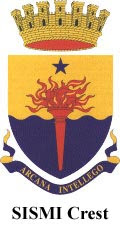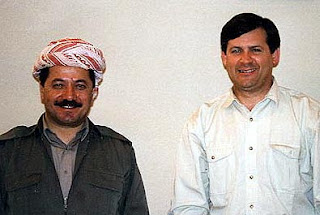An article by NBC News Senior Investigative Producer Bob Windrem
Did Saddam minister help the U.S.?
Why a former CIA officer says he should not be killed
ANALYSIS
By Robert Windrem
Senior Investigative producer
NBC News
For more than a year, Rick Francona, then an Air Force lieutenant colonel, was part of a secret CIA task force working to overthrow Saddam Hussein, the Clinton administration’s failed attempt at regime change in Iraq.
Now an NBC News analyst, Francona is talking for the first time about his role in recruiting generals for that mission seven years before the US invasion, and laying out why he thinks the US should try to stop the hanging of former Iraqi Defense Minister Sultan Hashim Ahmed, one of the generals recruited in that effort.
Hashim has been convicted of war crimes by an Iraqi court and is scheduled to hang in the next few days, unless the US military can quietly get the Iraqi government to commute his sentence.
“I moved in and out of northern Iraq, as well as the countries bordering Iraq,” says Francona. “We were involved in what was known inside the Agency as “DBACHILLES” – the overthrow of Saddam Hussein.
“We at CIA had tried to contact and co-opt as many Iraqi military officers as we could, hoping to convince them that they should not fight when and if an invasion or coup attempt occurred. That program had some successes.”
Francona says that he does not know what help Hashim provided, but notes that there is ample evidence he offered to help and that he was told that Hashim even volunteered to have communications gear hidden at his estate north of Baghdad in preparation for a coup attempt. Moreover, Jalal Talabani, the man who brought Hashim to the CIA’s attention, and now President of Iraq, has said publicly that the defense minister “cooperated” in the effort, Francona notes.
“DBACHILLES”--the DB was the CIA designator for Iraqi operations—was based on what the agency thought was the dictator’s Achilles’ heel: a military whose loyalty even Saddam questioned. Saddam understood the professional military was more loyal to the nation than it was to him. That was one reason why he had set up the Republican Guard and the Special Security Organization as well as a host of intelligence and counter intelligence organs. They were loyal to him personally. Better paid and better equipped than the military, the Guards and SSO were Saddam’s last line of defense. The military, the CIA believed, was vulnerable to recruiting pitches that played on their patriotism.
So during 1995-96, Francona was temporarily assigned from his role as a Defense Intelligence Agency officer to the CIA. He was uniquely equipped for the duty. Fluent in Arabic, Francona had worked out of the defense attaché office in Baghdad at the end of the Iran-Iraq War. As a Defense Intelligence Agency official, he had worked as America’s liaison officer to Iraq’s Directorate of Military Intelligence. He traveled extensively observing Iraqi combat operations against Iranian forces, and even flying sorties with the Iraqi air force. It was Francona, in fact, who had shown Iraqi intelligence officials US satellite photos of the Iran-Iraq battlefield and it was Francona who first gathered the proof that Iraq had used nerve gas on Iranian troops in 1988.
Then, he got another view of Iraq’s military during the Gulf War. He served as General Norman Schwarzkopf's translator, reading intelligence reports, briefing Schwarzkopf, and ultimately translating Schwarzkopf's commands to defeated Iraqi generals, one of whom turned out to be Hashim.
The agency set him up in Kurdistan, the northern section of Iraq no longer under Saddam’s control. Working out of a heavily sandbagged house in Sal-ah-din, Francona worked with Kurdish officials and ran several operations, training Kurdish pershmerga militants, extricating the family of an Iraqi nuclear scientist who had defected and meeting regularly, even daily, with Kurdish leaders, including Talabani. At the time, Talabani was head of the PUK, the Patriotic Union of Kurdistan, the main Kurdish opposition group. He is now President of Iraq.
“I met with Talabani on numerous occasions. I was a guest in his home, we had professional meetings almost daily,” says Francona. “In 1996, we were involved in supporting the Kurds and other opposition groups operating out of northern Iraq, also other countries in the region.
“Part of that was cooperating with the PUK, and Jalal Talabani, in a meeting told us he had taken steps to contact people in the Iraqi administration, and one of them being Sultan Hashim.”
Francona explained that during a meeting with “Mam Jalal”, Talabani’s nickname in Iraq, he revealed that he had made contact with a “senior member of the Saddam regime” who was willing to work with the CIA to remove Saddam. Francona asked who he was talking about…”Obviously this was of great interest to us.”
Talabani explained that he was working with Hashim on the overthrow of Saddam. Francona understood instantly the importance of . He had been the Deputy Director of Operations of the Iraqi armed forces in March 1991, the man who had surrendered to Schwartzkopf at Safwan in southern Iraq.
"Talabani told us, the Central Intelligence Agency, that he had been in contact with Sultan Hashim Ahmed, and that Sultan Hashim was willing to cooperate with us in removing Saddam Hussein from power,” says Francona.
The recruiting of Hashim was kept separate from the recruiting of lesser Iraqi generals. Still, at one point, Hashim’s name was entered into a CIA database as an “agent of influence.” An operation was approved. Francona says he does not know for certain what happened after that. Talabani was handling Hashim. But Francona says he was told: “There was a meeting between an intermediary and Sultan Hashim at a farm…we would call it an estate. My recollection is that we could hide some communications gear there and would be used to communicate with Sultan Hashim”.
Did he help? Francona says he doesn’t know. Officially, the CIA declines comment. A former CIA official says he doesn’t think Hashim did much if anything, but Talabani said last month that he cannot morally sign an execution order for Hashim’s hanging as President of Iraq, stating bluntly, “He used to cooperate”.
"I had known him. He had relations with us during Saddam's regime," Talabani told a press conference in the Kurdish city of Sulaimaniyah. "We were urging him to revolt against Saddam. How can I today sign his execution order when I was the one who provoked him then to rebel against Saddam. No, No, No. I will not do it. I used to urge him to rebel against the government and he used to cooperate so how can I now authorize his execution? I just cant."
Francona says that Talabani has a problem with the death penalty in general. He wouldn’t sign Saddam’s execution order, letting a deputy do it. But the case of Sultan Hashim is different.
"Talabani hasn't signed anybody's death warrant,” says Francona. “He's designated that responsibility to somebody in his office, but he does not want Sultan Hashim executed, he's tried to get clemency for him. So, he's not going to sign any death warrant.”
Talabani can’t issue a clemency order. Only Nouri al Maliki and the Iraqi courts have that right. Now, the question is whether the US military can convince them to commute the death penalty to life in prison. Time is short. Hashim could be hanged in the next few days.
If he is, says Francona, it will not be a good thing for US intelligence, even if Sultan Hashim’s cooperation was minimal.
“If Sultan Hashim was willing to cooperate with us, if he did cooperate with us, now he finds himself facing Iraqi justice - it just doesn't seem right to me,” he says. “I think we owe him the benefit of the doubt, and at least get his sentence commuted to life imprisonment. But to have him executed really does us no good.
“This sets a really bad precedent for people who are willing to cooperate with the United States. If they're willing to cooperate with the United States, and then, they find themselves justice in their own country, why would anybody cooperate with us in the future?”
© 2007 MSNBC Interactive






.jpg)
